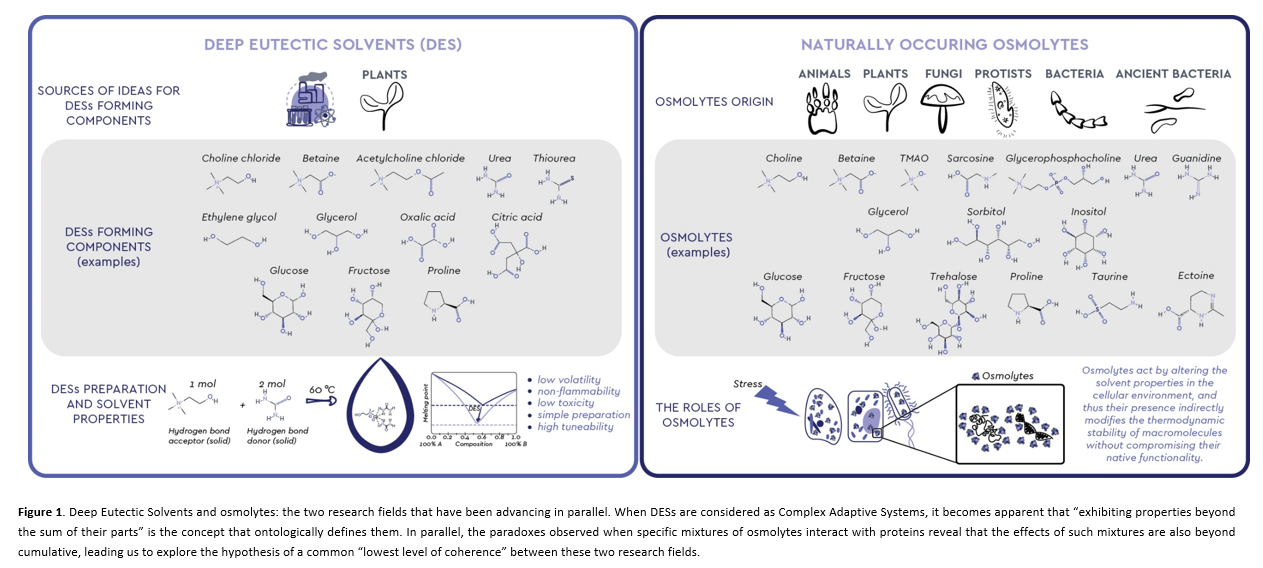

A little more than a year ago, we discussed the potential of Natural Deep Eutectic Solvents (NADES) with the leading members of the NADES Design University group of the Faculty of Food Technology and Biotechnology at the University of Zagreb.
We are now excited to announce the first fruit of this scientific collaboration, a Perspective article, just published in the Green Chemistry journal of the Royal Society of Chemistry: Natural multi-osmolyte cocktails form deep eutectic systems of unprecedented complexity: discovery, affordances and perspectives
Dr Thanos Andreou (Scientific Affairs – VIO Chemicals) and Asst. Prof. Marina Cvjetko Bubalo (UZAG) introduce a new way of looking at biological systems, in particular at the natural distribution patterns of small molecules called osmolytes.

Osmolytes are small molecules produced in cells as a response to external stimuli. Based on their individual interaction with macromolecules, single osmolytes are currently categorized as “kosmotropes” (stabilizing proteins) and “chaotropes” (destabilizing them). However, with two or more osmolytes, synergistic effects were also observed on top of cumulative ones. All current attempts to explain these synergistic effects have been studying osmolyte-osmolyte interactions in aqueous solutions, but none has been generally applicable so far, indicating that a new model “beyond kosmotropes and chaotropes” is needed to understand their function in natural systems. Thanos, Marina and the team at the NADES Design research group have gathered enough evidence to formulate a hypothesis of such a new model.
They were initially intrigued by the structural similarity between osmolytes and common DES components, but also by the fact that osmolytes are usually present in cells and tissues in certain combinations, strikingly similar or identical to those used for the preparation of synthetic DESs. Based on these observations, they decided to explore the pool of naturally occurring osmolytes and the patterns of their natural distribution in order to form novel, osmolyte-based DESs.
First, inspired by patterns frequently observed in nature, five major stabilizing osmolytes (kosmotropes) prominent across kingdoms (trimethylamine N-oxide, sarcosine, glycerophosphorylcholine, dimethylsulfoniopropionate and ectoine) were for the first time employed to form novel two- and three-component Deep Eutectic Solvents with all known natural perturbants/chaotropes (urea, guanidine hydrochloride and arginine).
Going beyond the current three-component barrier, they also mimicked the exact composition of multi-osmolyte cocktails widely observed in nature and observed the rapid and consistent formation of deep eutectic systems of unprecedented complexity and the tunable potential of these new systems to stabilize a template protein.
As a result, Thanos and Marina’s original idea has now been elaborated into the following assemblage, triggering new research ideas and opening up new opportunities for action:
Through their constant interaction with biomacromolecules, osmolyte-based microenvironments regulate a myriad of cellular properties, enable intra- and extracellular information flows and facilitate the “enactive” functions of the components of biological systems.
Could osmolyte-based deep eutectic media be employed to better monitor these flows in complex natural systems and allow for the emergence of new properties and affordances we can explore and exploit?
And could this new knowledge be leveraged to enable information flows within engineered systems?
△